Targeted investments help balance growth
Updated: 2014-12-08 10:52
By MARK PURDY/JING QIU(China Daily)
|
|||||||||||
|
 |
|
ZHANG CHENGLIANG/CHINA DAILY |
Deploying capital in the right areas can stimulate household consumption in China
Investment in fixed assets-roads, buildings, machinery and other infrastructure-has powered China's economy for the last two decades. But at the same time, many commentators worry that China's growth model relies too heavily on increasingly inefficient investments and that, as a result, its economy has become dangerously unbalanced.
While seemingly compelling, the conventional over-investment story is misleading in certain respects.
Accenture's research shows that on some measures China may need more capital, not less. However, the key issue facing China is the distribution of capital and how it is used.
In fact, investments in the right areas can stimulate household consumption and provide an entirely new source of balanced growth.
China's remarkable economic growth over the past decade has relied prominently on investment in fixed assets, which rose to 44 percent of GDP in 2012 from less than 30 percent in 1980. This share is much higher than those of other nations in the BRICS bloc (Brazil, Russia, India and South Africa) and developed economies.
Even taking into account the size of China's population, the country has accumulated capital at a staggering pace. For example, the nation's rate of capital deepening, or capital growth per person, has increased faster than in any other major economy during the past two decades. And in recent years, the pace has increased: In the last decade, China's capital stock per capita grew by over 11 percent a year, markedly faster than in other economies.
At the same time, many commentators now argue that this flood of capital has caused China's economy to become dangerously unbalanced. Some analysts point to oversupply in property markets, low prices and excess capacity in certain industries as further evidence of a capital spending glut.
As a result, many experts and Western governments have raised doubts about the sustainability of the investment-driven economic growth model. They say that China is over-investing and heading for a crash. While investment may be the bedrock of China's economic growth, experts worry that it could also become the nation's Achilles' heel.
It is not a problem in itself. The view that China is dangerously addicted to fixed-asset investment seems compelling. But on closer examination, some key indicators relating to China's capital stock appear to be at odds with the conventional over-investment story. At the very least, they indicate a more complex picture where the key challenges relate to the distribution and use of capital rather than to volume alone.
Let's look at these indicators in turn.
Incremental capital to output ratio: It measures how efficiently an economy uses capital to create goods and services. A low ICOR indicates a relatively efficient use of capital: Fairly low capital expenditure is needed to produce additional output. As the data show, over the past three decades, at an aggregate economy level, China has seen some deterioration in the efficiency of investment but not dramatically so. From an international perspective, China's ICOR levels also look reasonable. If anything, China's ICOR is more stable and lower than those of other countries. Moreover, in recent years, China's annual capital efficiency has been better than that of the US, the UK, Japan, South Korea and Singapore.
Related Stories
Investment 'welcome' in oil and gas 2014-12-05 08:46
New investment form to cut cost, fuel growth 2014-12-06 14:27
China eases market access to boost investment 2014-11-26 16:31
China loosens outbound investment control 2014-11-19 07:42
China continues 'new normal' growth: Morgan Stanley 2014-11-22 17:25
China determined to solve major problems in economy 2014-11-17 16:38
Today's Top News
Former Scottish first minister to seek UK Parliament seat
Prince William and Kate arrive on first trip to NYC
Former French PM celebrates China Daily's Climate Watch debut
Chinese help sought in UK name game
US, Britain pledge to support Afghanistan
HK visit: A political kabuki
Ukraine unlikely to join NATO in near future
Hotpot chain to raise $129m
Hot Topics
Lunar probe , China growth forecasts, Emission rules get tougher, China seen through 'colored lens', International board,
Editor's Picks

|

|

|

|

|

|





